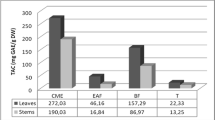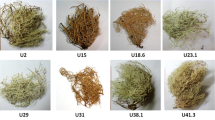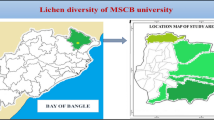Abstract
Antioxidant agents prevent reactive oxygen species, which can cause degenerative diseases. Natural antioxidants are preferred over many synthetic antioxidants, which can be toxic, for therapeutic applications. Five lichen species were collected from King George Island, Antarctica. Antioxidant activities as assessed by DPPH (1,1-diphenyl-2-picrylhydrazyl) free radical and ABTS•+ [2,2’-azinobis-(3-ethylbenzothiazoline-6-sulfonate)] radical scavenging capacities were determined and compared with those of commercial standards BHA (butylated hydroxyanisole) and trolox [(±)-6-hydroxy-2,5,7,8-tetramethylchromane-2-carboxylic acid]. The results indicated that two lichens exhibited comparatively high antioxidant activities with the remaining three exhibiting less activity. The antioxidant activity was concentration-dependent. When compared, the antioxidant activity of crude extracts from polar lichens to previously published data for tropical and temperate lichen species, we concluded that lichens of Antarctic origin may be the potent sources of strong antioxidant agents. Such species should be explored as novel sources of effective antioxidant metabolites.
Similar content being viewed by others
Explore related subjects
Discover the latest articles, news and stories from top researchers in related subjects.Avoid common mistakes on your manuscript.
Introduction
Oxidation reaction produces free radicals that promote damaging reactions for many cellular components. Reactive oxygen species (ROS) and oxygen radicals damage cells thereby enhancing a number of degenerative diseases such as premature aging, inflammation, deoxygenation of ischemic tissues, atherosclerosis and cancer (Halliwell and Gutteridge 1990). Free radicals attack unsaturated fatty acids of cell membranes resulting in lipid peroxidation, decrease in membrane fluidity and damage to membrane proteins (Dean and Davies 1993). Oxidative stress is assocated with many environmental factors and aging, but some oxidative pathologies can be treated with antioxidant agents (Totour 1990). Antioxidant agents terminate oxidative chain reactions by removing free radical intermediates, thereby preventing oxidation of cellular components. Several reports of strong synthetic antioxidant propoerties have been published in past years (Funasaka et al. 1999; Shimizu et al. 2001). Because of the high carcinogenicity of synthetic antioxidants (Grice 1986; Wichi 1988), developing effective natural antioxidants may have significant implications for human health.
Lichens are non-flowering living things that are composed of an alga (phycobiont) and a fungus (mycobiont), living symbiotically. Because of a lack of an easy method for industrial scale lichen culture, and difficulties in collecting wild samples, for research, research into lichen metabolites has advanced slowly. In the past decade some investigations into lichen culture, production, biochemical analysis and metabolites have been described (Crittenden and Porter 1991; Yamamoto et al. 1998; Behera et al. 2006). Several bioactive secondary metabolites, especially antimicrobial and antioxidant compounds have been observed in lichens from the wild, and in cultured species of tropical origin (Boustie and Grube 2005; Behera et al. 2007).
Various lichen metabolites from several chemical class types including: diterpene, usnic acid, triterpene, dibenzofuran, depside, pulvinic acids and xanthones have been described. These exhibit a range of biological activities including: cytotoxic, fungicidal, antimicrobial, herbicidal, anti-inflammatory activities, as reviewed by Dayan and Romagni (2001). A new UV-B absorbing mycosporine was isolated from the lichenized ascomycete Collema cristatum, collected from Israel (Torres et al. 2004). Two cytotoxic naphthopyrones, namely euplectin and coneupletin, were obtained from the Australian species Flavoparmelia euplacta (Ernst-Russell et al. 2000). Anti-inflammatory phenolic compounds longissiminone A and longissiminone B were isolated from Usnea longissima from Pakistan (Choudhary et al. 2005). Papadopoulou et al. (2007) reported ABTS [2,2’-azinobis-(3-ethylbenzothiazoline-6-sulfonate)] radical scavenging activities for nine secondary metabolites from the lichen Hypotrachyna revoluta, collected from Southern Greece.
There are very few reports (Ansaldo et al. 2000) of antioxidant activities for secondary metabolites for Antarctic and Arctic organisms. In this paper we have collected five lichen species from Antarctica and tested their antioxidant activities in comparison with commercially available antioxidant standards: DPPH (1,1-diphenyl-2-picrylhydrazyl) and a vitamin E analog, trolox [(±)-6-hydroxy-2,5,7,8-tetramethylchromane-2-carboxylic acid].
Materials and methods
Lichen specimens and collection
Five lichen species: L3 (Stereocaulon alpinum Laurer) (Stereocaulaceae), L5 (Ramalina terebrata Hook and Taylor) (Ramalinaceae), L6 (Caloplaca sp.) (Teloschistaceae), L8 (Lecanora sp.) (Lecanoraceae) and L17 (Caloplaca regalis (Vain.)Zahlbr.) (Teloschistaceae), were collected from the Korean Antarctic Research Station site on King George Island (61°50′–62°15′S and 57°30′–59°01′W), Antarctica. All the species were identified by Dr. Soon Gyu Hong by comparing morphological characteristics with those previously published (Vstedal and Lewis Smith 2001). L6 and L8 were tentatively identified on the basis of morphological characteristics. The identification of L3, L5 and L17 was confirmed by comparing partial sequences of the ITS (internal transcribed spacer) region. GenBank accession number of the ITS regions for L3, L5 and L17 are EU161238, EU161239 and EU161240, respectively. Voucher specimens were deposited in the Polar Lichen Herbarium, Korea Polar Research Institute, KOPRI, Incheon, South Korea.
Lichen extraction
Various dry weights of specimens (Table 1) were separately extracted in methanol-water (90:10 v/v) at room temperature (RT). The solvent was evaporated in vacuum at 45°C and samples were then lyophilized. Crude extracts were stored at −20°C until further use.
Chemicals and reagents
Antioxidant assay kit (Product code CS0790), Butylated hydroxyanisole (BHA) and 1,1-diphenyl-2-picrylhydrazyl (DPPH) were purchased from Sigma. All other reagents and solvents used during this experiment were analytical grade.
Antioxidant assay
DPPH free-radical scavenging capacity
The free-radical scavenging capacity of the lichen extracts was estimated by a previously described method (Blois 1958). One mL of DPPH solution (0.1 mM of DPPH in methanol) was mixed with 3 ml of various concentrations of the lichen extract. The mixture was incubated at RT for 30 min and the absorbance was measured at 517 nm in a UV-Visible spectrophotometer (SCINCO- AMERICA) to measure the content of DPPH free radical. Reaction mixtures without the lichen extract were used as a negative control and various concentrations of BHA were used as positive controls. Experiments were conducted in triplicate.
ABTS•+ scavenging capacity
The ABTS•+ scavenging capacity of the lichen extracts was determined by comparison with a commercially available, water soluble vitamin E analog, trolox (6-hydroxy-2,5,7,8-tetramethylchroman-2-carboxilic acid) as a standard (Rice-Evans and Miller 1994). A standard curve for ABTS•+ scavenging capacity was obtained using 0–100 μg ml−1 of trolox. The water soluble methanol extract of each lichen was applied to a free radical (cation) generation system where chromogen cations of ABTS (2, 2′-azino-bis (3-ethylbenzthiazoline-6-sulfonic acid) were produced by oxidizing ABTS a with ferryl myoglobin radical. The ferryl myoglobin radical came from the reaction between metmyoglobin and hydrogen peroxide. The ABTS radical was green and could be read spectrophotometrically at 405 nm. The antioxidant activity of trolox suppressed the production of the ABTS radical in a concentration-dependent manner, and the color intensity decreased proportionally. After comparison with the trolox standard, the ABTS•+ scavenging capacity of crude lichen extracts was expressed in trolox-equivalent terms.
Results and discussion
We used two electron transfer (ET) based antioxidant assays (DPPH free radical and ABTS+ scavenging capacities) to evaluate the antioxidant activities of five lichen species from King George Island. The ET-based assays measured the capacity of an antioxidant to reduce an oxidant that, when reduced, changed color reproducibly (Huang et al. 2005). The degree of color change was correlated with antioxidant potential in lichen extracts.
The DPPH free radical scavenging capacity of the methanol extracts from all five lichen species are presented (Fig. 1). All the tested extracts, and a commercial standard sample (BHA) (figure not shown), exhibited DPPH free radical scavenging capacity in a concentration-dependent manner. However, the rate of scavenging capacity was variable for each extract. The IC50 (the 50% inhibition) concentration (Table 1) of each lichen extract was calculated after regression analyses of the observed data. On the basis of the calculated IC50 concentration, the DPPH free radical scavenging capacities of lichen extracts were found in following order: L6 ≥ L8 > L17 > L5 > L3. BHA is a strong antioxidant agent and, in the present experiment, the IC50 of this compound was observed to be 3.5 ± 0.2 μg ml−1.
Concentration-dependent ABTS•+ scavenging capacities of water-soluble extracts from five Antarctic lichen species were observed (Fig. 2). However, the rate of ABTS•+ scavenging capacity varried between extracts. The ABTS•+ scavenging IC50 for each extract was calculated (Table 1). The data showed that the trend of ABTS•+ scavenging capacity for the lichen extracts examined was as follows: L8 > L6 > L17 > L5 > L3. The commercial standard, trolox showed an IC50 of 46.35 ± 0.1 μg ml−1.
Two ET-based assays were applied to evaluate the antioxidant activities of lichen extracts. However, there was a difference in the solvent system used for different reaction mixtures. In the DPPH free radical assay, the reaction was carried out in methanol, while the ABTS•+ scavenging assay was under aqueous conditions. The antioxidant capacities shown in DPPH scavenging assays were due to the presence of methanol soluble antioxidant active agents in the lichen extracts, whereas the antioxidant capacity shown in the ABTS•+ assay was due the presence of water-soluble antioxidant agents. Comparisons of the IC50s of each assay revealed that water soluble components of the lichen extracts appeared to be more active than methanol soluble components (except for L5 and L17). In the case of L5 and L17, the methanol soluble extract was comparable to the aqueous extract.
The activities of putative antioxidants have been attributed to various mechanisms, such as prevention of chain initiation, binding of transition metal ion catalysts, decomposition of peroxides, prevention of continuous hydrogen abstraction and radical scavenging (Diplock 1997; Yilidirim et al. 2001). Lichens were observed to produce several phenolic compounds as secondary metabolites (Nash 1996). Because of the ability of phenolic compounds to scavenge free radicals and reactive oxygen species (such as singlet oxygen, superoxide free radicals and hydroxyl radicals) phenolic compounds have been described as effective antioxidants (Hall and Cuppett 1997). Therefore, it is likely that effective antioxidants are present in lichen extracts. Several lichen species of tropical and temperate origin (Behera et al. 2006) have shown antioxidant activities in higher dose (mg ml−1) level. We found that polar lichens exhibit antioxidant activities at a relatively low-dose level (μg ml−1). Therefore, it can be concluded that polar lichens are a potentially impressive source of strong antioxidant agents when compared to tropical lichens. Therefore, these Antarctic lichen species should be explored further, especially through laboratory culture of the lichen species for mass production. Furthermore, the isolation and characterization of the antioxidant secondary metabolites from the specimens should be explored for therapeutic development.
References
Ansaldo M, Luquet CM, Evelson PA, Polo JM, Llesuy S (2000) Antioxidant levels from different Antarctic fish caught around South Georgia Island and Shag Rocks. Polar Biol 23:160–165
Behera BC, Verma N, Sonone A, Hakhija U (2007) Tissue culture of some lichens and screening of their antioxidant, antityrosinase and antibacterial properties. Phytother Res (in press) (10.1002/ptr.2228)
Behera BC, Verma N, Sonone A, Makhija U (2006) Determination of antioxidative potential of lichen Usnea ghattensis in vitro. Lebenson Wiss Technol 39:80–85
Blois MS (1958) Antioxidant determinations by the use of a stable free radical. Nature 26:1199–1200
Boustie J, Grube M (2005) Lichens- a promising source of bioactive secondary metabolites. Plant Genet Resour 3:273–287
Choudhary MI, Azizuddin SJ, ur-Rahman A (2005) Bioactive phenolic compounds from a medicinal lichen Usnea longissima. Phytochemistry 66:2346–2350
Crittenden PD, Porter N (1991) Lichen forming fungi: potential source of novel metabolites. Trends Biotechnol 9:409–414
Dayan FE, Romagni JG (2001) Lichens as a potential source of pesticides. Pestic Outlook 12:229–232
Dean RT, Davies MJ (1993) Reactive species and their accumulation on radical damaged proteins. Trends Biochem Sci 18:437–441
Diplock AT (1997) Will the good fairies please proves to us that vitamin E lessens human degenerative of disease? Free Radic Res 27:511–532
Ernst-Russell M, Chai CLL, Wardlaw JH, Elix JA (2000) Euplectin and coneuplectin, new naphthopyrones from the lichen Flavoparmelia euplecta. J Nat Prod 63:129–131
Funasaka Y, Chakraborty AK, Komoto M, Ohashi A, Ichihashi M (1999) The depigmenting effect of α-tocopheryl ferulate on human melanoma cells. Br J Dermatol 141:20–29
Grice HC (1986) Safety evaluation of butylated hydroxytoluene (BHT) in the liver, lung and gastrointestinal tract. Food Chem Toxicol 24:1127–1130
Hall CA, Cuppett SL (1997) Structure-active of natural antioxidant. In: Auroma OI, Cuppett SL (eds) Antioxidant methodology in vivo and in vitro concepts. AOCS Press, Champaign, IL, pp 141–170
Halliwell B, Gutteridge JM (1990) Role of free radicals and catalytic metal ions in human disease: an overview. Methods Enzymol 186:1–88
Huang D, Ou B, Prior RL (2005) The chemistry behind antioxidant capacity assays. J Agric Food Chem 53:1841–1856
Nash TH (1996) Lichen biology. Cambridge University Press, Grate Britain, pp 1–289
Papadopoulou P, Tzakou O, Vagias C, Kefalas P, Roussis V (2007) β-Orcinol metabolites from the lichen Hypotrachyna revoluta. Molecules 12:997–1005
Rice-Evans C, Miller NJ (1994) Total antioxidant status in plasma and body fluids. Methods Enzymol 234:279–293
Shimizu K, Kondo R, Sakai K, Takeda N, Nagahata T, Oniki T (2001) Novel vitamin E derivative with 4-substituted resorcinol moiety has both antioxidant and tyrosinase inhibitory properties. Lipids 36:1321–1326
Torres A, Hochberg M, Pergament I, Smoum R, Niddam V, Dembitsky VM, Temina M, Dor I, Lev O, Srebnik M, Enk CD (2004) A new UV-B absorbing mycosporine with photo protective activity from the lichenized ascomycete Collema cristatum. Eur J Biochem 271:780–784
Totour BL (1990) Antioxidant activities of algal extracts. Synergistic effect with vitamin E. Phytochemistry 29:3759–3765
Vstedal DO, Lewis Smith RI (2001) Lichens of Antarctica and South Gerogia. Cambridge University Press, Cambridge, pp 77–366
Wichi HP (1988) Enhanced tumor development of butylated hydroxyanisol (BHA) from the prospective of effect on fore stomach and oesophageal squamous epithelium. Food Chem Toxicol 26:717–723
Yamamoto Y, Mizuguchi R, Takayama S, Yamada Y (1987) Tissue cultures of Usnea rubescense and Ramalina yasudae and production of usnic acid in their cultures. Agric Biol Chem 49:3347–3348
Yilidirim A, Oktay M, Bilaloglu V (2001) The antioxidant activity of the leaves of Cydonia vulgaris. Turk J Med Sci 31:23–27
Acknowledgment
This work was supported by a grant to the Korea Polar Research Institute, KOPRI, under project PE07050.
Author information
Authors and Affiliations
Corresponding author
Rights and permissions
About this article
Cite this article
Paudel, B., Bhattarai, H.D., Lee, J.S. et al. Antioxidant activity of polar lichens from King George Island (Antarctica). Polar Biol 31, 605–608 (2008). https://doi.org/10.1007/s00300-007-0394-8
Received:
Revised:
Accepted:
Published:
Issue Date:
DOI: https://doi.org/10.1007/s00300-007-0394-8






